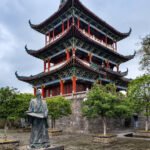Tianhua Hall, originally a quiet room known as Qinglian Tai, was rebuilt into a hermitage by monk Fujin during the Qing Xianfeng years and was destroyed by fire in the 25th year of Guangxu’s reign (1899). Later, it was reconstructed by monk Yuede, with a scale surpassing the old hermitage, comprising 82 halls and a construction area of 2621 square meters. In the early years of liberation, eight monks including Xiutian, Hui Xiang, Jingyu, and Jingqian resided there. After the land reform, monks and laypeople lived together, and from 1960, it was inhabited by 52 local farmers.

Bai Zi Tang, originally a thatched cottage named ‘Liu He An’, was founded by Zen Master Xinyi in the early Qing Kangxi period and named ‘Liu He An’. In the late Kangxi period, his disciples Guangbo and Xujing expanded and built the Great Compassion Pavilion, renaming it ‘Bai Zi An’. In the 27th year of Guangxu (1901), monk Jide built the outer mountain gate. In the spring of 1923, the Hall of the Bestower of Sons and the buildings were added, renaming it Bai Zi Tang, with a total of 80 halls and a construction area of 2597.42 square meters. In the early years of liberation, six monks including Zhenghui, Jingqing, and Yongbin resided in this hermitage. After the land reform, monks and laypeople lived together, and from 1960, it was inhabited by 40 local farmers.
To promote the Buddhist culture and accelerate the sustainable development of Buddhism and tourism in Putuo Mountain, the local government has been planning and vacating the old hermitages inhabited by local people year by year after Putuo Mountain was reopened. Tianhua Hall has over 80 halls, with the main hall, the Mahavira Hall, enshrining the statues of Sakyamuni, Manjushri, Samantabhadra, and the ten great disciples of the Buddha. Bai Zi Tang has over 80 halls with a construction area of 2500 square meters. The main hall, the Great Compassion Hall, enshrines the statue of the Thousand-Armed and Thousand-Eyed Avalokitesvara Bodhisattva and the twenty-eight divisions. Behind the main Buddha statue, the statue of Ksitigarbha Bodhisattva, who saves all beings in the dark and bright realms, is enshrined. The Hall of the Bestower of Sons has been restored to its original appearance, enshrining the Bestower of Sons Avalokitesvara. Below the Hall of the Bestower of Sons is the ‘Three Jewels Buddha Hall’, with the Heavenly Kings Hall enshrining the hundred-son Maitreya Buddha and the two protective deities, the Child Renwang.
The Buddha statues in Bai Zi Tang and Tianhua Hall are all made from the rare and precious wood, cypress, which can be considered a unique masterpiece among the many temples on Putuo Mountain, a fine example of Buddhist statue art. Especially the Bestower of Sons Avalokitesvara in the Hall of the Bestower of Sons at Bai Zi Tang, it is an excellent place for those who seek blessings for children. Since the Qing Kangxi period when it was known as ‘Bai Zi An’, there have been countless miraculous instances of the Avalokitesvara granting children. After the construction of the Hall of the Bestower of Sons, the fame of Tianhua Bai Zi Tang’s Bestower of Sons Avalokitesvara spread far and wide. The Mahayana sutra, ‘Avalokitesvara’s Universal Gate Chapter’, records: ‘If one wishes to have a son, by worshiping and offering to Avalokitesvara, one will have a son with virtue and wisdom. If one wishes to have a daughter, one will have a daughter with proper appearance and demeanor, with a foundation of virtue from past lives, loved and respected by all.’ It is said that Avalokitesvara Bodhisattva responds to all requests, with great spiritual powers and boundless inspiration. Tianhua Bai Zi Tang’s Bestower of Sons Avalokitesvara is a significant feature of the ‘Buddhist Kingdom by the Sea’, providing an ideal temple site for those who wish to have children.
Opening hours throughout the year: 06:30 – 21:50.







